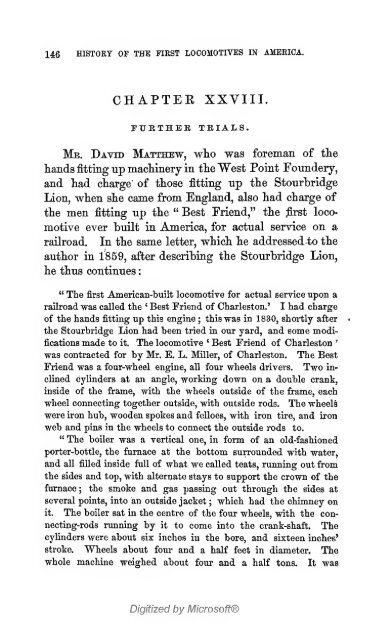The history of the first locomotives in America. From original ...
The history of the first locomotives in America. From original ...
The history of the first locomotives in America. From original ...
Create successful ePaper yourself
Turn your PDF publications into a flip-book with our unique Google optimized e-Paper software.
:<br />
146 HISTORY OF THE FIRST LOCOMOTIVES IN AMERICA.<br />
CHAPTEE XXVIII.<br />
rtJETHEE TEIALS.<br />
Me. David Mat<strong>the</strong>w, wlio was foreman <strong>of</strong> <strong>the</strong><br />
hands fitt<strong>in</strong>g np mach<strong>in</strong>ery <strong>in</strong> <strong>the</strong> "West Po<strong>in</strong>t Foundery,<br />
and had charge' <strong>of</strong> those fitt<strong>in</strong>g up <strong>the</strong> Stourhridge<br />
Lion, when she came from England, also had charge <strong>of</strong><br />
<strong>the</strong> men fitt<strong>in</strong>g np <strong>the</strong> " Best Friend," <strong>the</strong> ;<strong>first</strong> loco-<br />
motive ever built <strong>in</strong> <strong>America</strong>, for actual service on a<br />
railroad. In <strong>the</strong> same letter, which he addressed -to <strong>the</strong><br />
author <strong>in</strong> 1859, after describ<strong>in</strong>g <strong>the</strong> Stourbridge Lion,<br />
he thus cont<strong>in</strong>ues<br />
" <strong>The</strong> <strong>first</strong> <strong>America</strong>n-'built locomotive for actual service upon a<br />
railroad was called <strong>the</strong> ' Best Friend <strong>of</strong> Charleston.' I had charge<br />
<strong>of</strong> <strong>the</strong> hands fitt<strong>in</strong>g up this eng<strong>in</strong>e ;<br />
this was <strong>in</strong> 1830, shortly after<br />
<strong>the</strong> Stourbridge Lion had been tried <strong>in</strong> our yard, and some modi-<br />
fications made to it. <strong>The</strong> locomotive ' Best Friend <strong>of</strong> Charleston<br />
was contracted for by Mr. E. L. Miller, <strong>of</strong> Charleston. <strong>The</strong> Best<br />
Friend was a four-wheel eng<strong>in</strong>e, all four wheels drivers. Two <strong>in</strong>-<br />
cl<strong>in</strong>ed cyl<strong>in</strong>ders at an angle, work<strong>in</strong>g down on a double crank,<br />
<strong>in</strong>side <strong>of</strong> <strong>the</strong> frame, with <strong>the</strong> wheels outside <strong>of</strong> <strong>the</strong> frame, each<br />
wheel connect<strong>in</strong>g toge<strong>the</strong>r outside, with outside rods. <strong>The</strong> wheels<br />
were iron hub, wooden spokes and felloes, with iron tire, and iron<br />
web and p<strong>in</strong>s <strong>in</strong> <strong>the</strong> wheels to connect <strong>the</strong> outside rods to.<br />
" <strong>The</strong> boiler was a vertical one, <strong>in</strong> form <strong>of</strong> an old-fashioned<br />
porter-bottle, <strong>the</strong> furnace at <strong>the</strong> bottom surrounded with water,<br />
and all filled <strong>in</strong>side full <strong>of</strong> what we called teats, runn<strong>in</strong>g out from<br />
<strong>the</strong> sides and top, with alternate stays to support <strong>the</strong> crown <strong>of</strong> <strong>the</strong><br />
furnace ; <strong>the</strong> smoke and gas pass<strong>in</strong>g out through <strong>the</strong> sides at<br />
several po<strong>in</strong>ts, <strong>in</strong>to an outside jacket ; which had <strong>the</strong> chimney on<br />
it. <strong>The</strong> boiler sat <strong>in</strong> <strong>the</strong> centre <strong>of</strong> <strong>the</strong> four wheels, with <strong>the</strong> connect<strong>in</strong>g-rods<br />
runn<strong>in</strong>g by it to come <strong>in</strong>to <strong>the</strong> crank-shaft. <strong>The</strong><br />
cyl<strong>in</strong>ders were about six <strong>in</strong>ches <strong>in</strong> <strong>the</strong> bore, and sixteen <strong>in</strong>ches'<br />
stroke. Wheels about four and a half feet <strong>in</strong> diameter. <strong>The</strong><br />
whole mach<strong>in</strong>e weighed about four and a half tons. It was<br />
Digitized by Micros<strong>of</strong>t®<br />
'
















